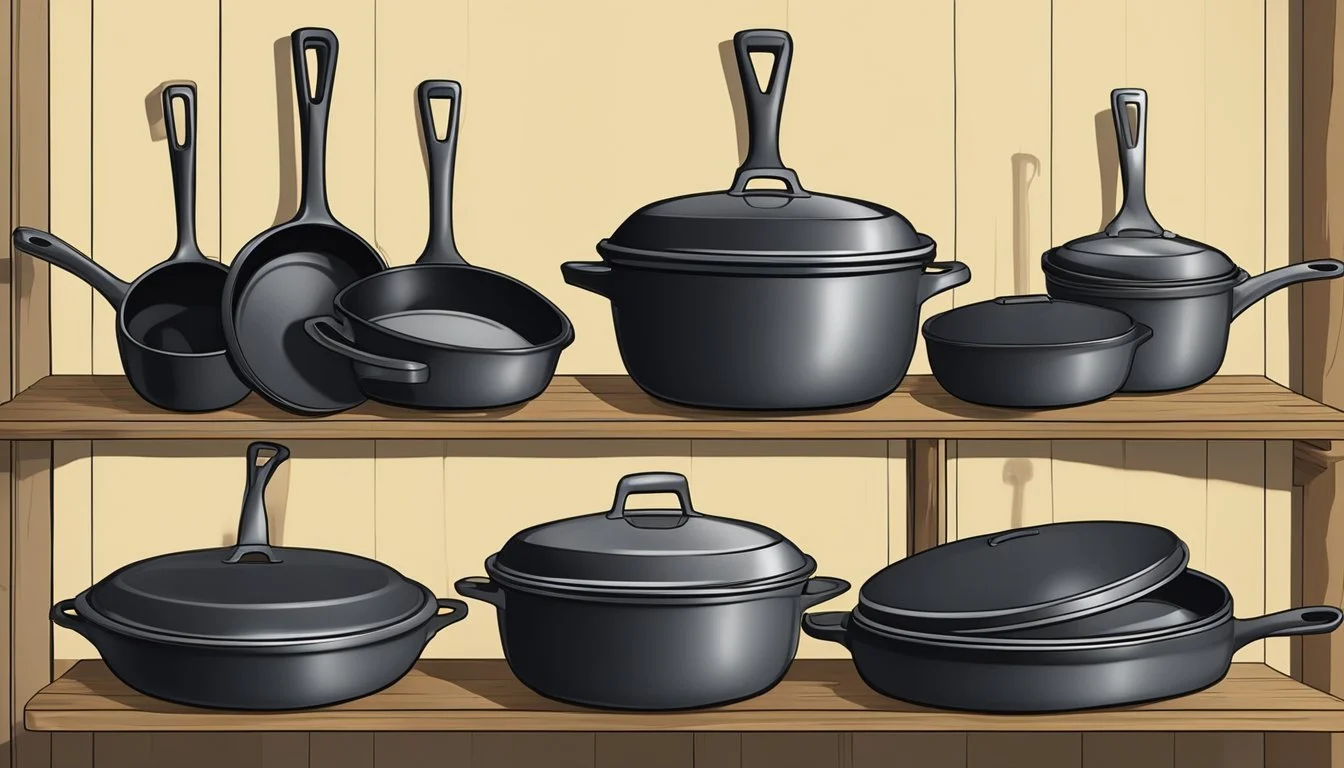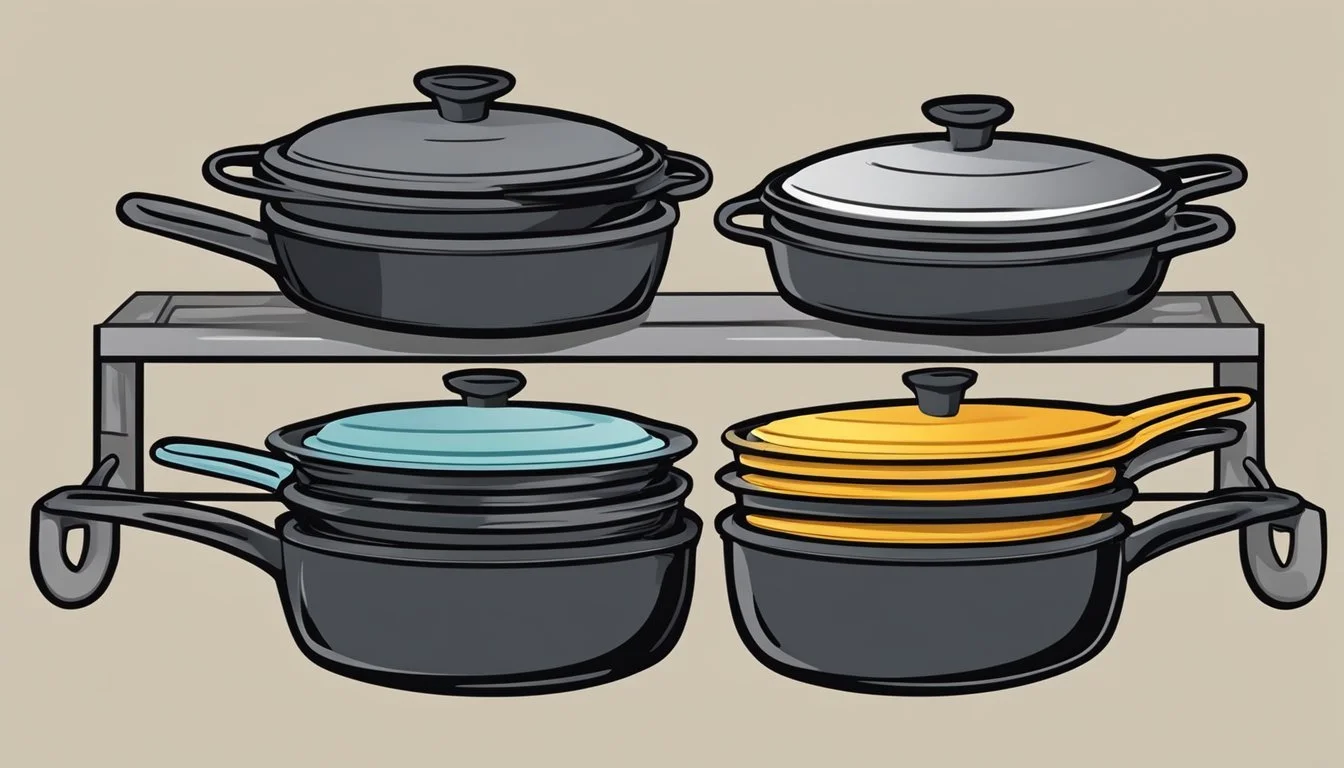The Best Way to Store Your Cast Iron Skillets
Tips for Longevity and Care
Cast iron cookware is prized for its durability and versatility in the kitchen. These heavy-duty pans can last generations if treated with care, ensuring a legacy of delicious meals. Proper storage is crucial to maintain the integrity of cast iron and keep it in prime cooking condition. Moisture is the enemy of cast iron, as it can lead to rust and degrade the skillet's seasoned surface. Therefore, finding the right storage solution that keeps cast iron dry and protected is imperative for any cook who values their investment.
The ideal method of storing cast iron involves a balance of accessibility and protection. In a kitchen, where space is often at a premium, cast iron can be stored in an oven or stovetop, as long as it's kept away from moisture. To prevent rust and maintain the non-stick surface, it's recommended to coat the skillet with a thin layer of oil after each use. Cleanliness is also a key factor—cast iron should be thoroughly cleaned and dried before storage to prevent any deterioration. Proper storage ensures these kitchen workhorses are always ready for cooking and will perform well for years to come.
Understanding Cast Iron Skillets
In the realm of cookware, cast iron skillets stand out for their versatility and longevity. The following subsections delve into the historical significance, distinct features, and the crucial practice of seasoning that make cast iron cookware a staple in kitchens worldwide.
History and Benefits of Cast Iron Cookware
Cast iron cookware has a storied heritage, tracing back centuries as a trusted tool for cooking. They are prized for not only their functional qualities in the kitchen but also their decorative potential. A well-made cast iron skillet can transition seamlessly from stovetop or oven to an elegant table setting. The durability of cast iron pieces means they often become heirlooms, passed down through generations.
Unique Properties of Cast Iron
Cast iron is admired for its unparalleled heat retention and even heating properties. Unlike lighter materials that may create hot spots, a cast iron skillet distributes heat uniformly across its surface. This makes them ideal for searing, frying, and even baking. Their heft, although heavier than other types of pans, contributes to their stability and resilience on any cooking surface.
Importance of Seasoning for Cast Iron Skillets
Seasoning is a layer of polymerized oil baked onto the cast iron's surface, creating a non-stick sheen that protects the skillet from corrosion. Regular seasoning maintains the non-stick properties and prevents rust, ensuring the longevity of the skillet. A well-seasoned cast iron skillet improves with use, gradually becoming more non-stick over time, which underscores the importance of proper care and storage.
Pre-Cleaning and Preparation
Before storing your cast iron skillets, thorough cleaning and preparation are essential to maintain their quality and longevity. Understanding the correct methods for pre-cleaning and oil application can prevent rust and ensure the skillet is ready for its next use.
Cleaning Your Cast Iron Skillets Properly
To clean a cast iron skillet, one should begin immediately after cooking when the skillet is warm but cool enough to handle. They should remove any leftover food using a spatula or brush and then rinse the skillet with hot water. If necessary, a small amount of soap and a non-metal sponge can be used to clean the surface, though this is often debated among enthusiasts. To tackle tough residue, they might use a paste of coarse kosher salt and water, which can act as a gentle abrasive.
Remove food particles with a spatula or brush.
Rinse with hot water; use mild soap and a non-metal sponge if needed.
For stubborn residue, apply a paste of coarse kosher salt and water.
Drying and Applying Oil
After cleaning, the skillet must be dried completely to prevent rust. An individual should wipe the skillet down with a kitchen towel before placing it on a stove over low heat to evaporate any remaining moisture. Once dry, they apply a very thin layer of cooking oil to the entire cooking surface. This step is crucial for protecting the skillet and maintaining its seasoning.
Dry thoroughly with a kitchen towel.
Heat on the stove over low heat until completely dry.
Lightly coat with cooking oil, avoiding excess.
Storing Your Cast Iron Skillets
Proper storage of cast iron skillets ensures their longevity and maintains their well-seasoned surfaces. Selecting the right location with methods to prevent rust, along with employing appropriate techniques for stacking and spacing, are crucial for the care of these kitchen essentials.
Selecting the Right Storage Location
The ideal storage area for cast iron cookware is a dry cabinet or drawer to protect them from moisture, which can lead to rust. A cabinet typically serves well, but one must ensure that it does not trap humidity. Some individuals prefer to store their skillets on the countertop or even on a stovetop, turning these utensils into a display of rustic kitchen charm, provided the environment is dry.
Methods to Prevent Rusting and Damage
Moisture is the enemy of cast iron, as it encourages rusting. One must always dry skillets thoroughly with a kitchen towel or paper towel after washing. To further prevent rust, it is recommended to lightly coat the skillet with a layer of oil before storing. This oil creates a barrier against air and moisture.
Wash the skillet promptly after use.
Dry completely with towels.
Oil the skillet lightly and ensure it's spread evenly.
Appropriate Stacking and Spacing Techniques
When storing multiple cast iron skillets, stacking should be done with care. Pans can be stacked inside one another to save space, but it is essential to place a layer of paper towel or a felt liner between them to prevent scratches and to absorb any residual moisture. Some individuals use cork trivets or even cloth liners to separate stacked pans, providing cushioning and air circulation.
Stack pans with a protective layer between each.
Avoid stacking too many pans, which can lead to wear or difficulty in retrieving them.
Storing cast iron skillets correctly not only keeps them ready for use but also preserves the cooking surface and prevents damage from rust and wear.
Maintaining Cast Iron Skillets
Proper maintenance of cast iron skillets ensures their longevity and enhances their non-stick properties. It involves routine cleaning and seasoning, addressing sticky residue, and occasional re-seasoning.
Routine Cleaning and Seasoning
After each use, one should clean cast iron cookware with hot water and a nylon brush or non-abrasive scrubber. A mild dish soap can be used sparingly. To avoid rust, they must immediately dry the skillet thoroughly with a dishcloth or paper towel. Following cleaning, they should apply a thin layer of oil—vegetable, olive, or canola oil—to the cooking surface and heat it on the stove over a low flame to help maintain the seasoning.
Do:
Clean while the skillet is still warm.
Use hot water for cleaning.
Dry immediately after washing.
Don't:
Soak the skillet.
Use steel wool or harsh detergents.
Dealing with Persistent Residue and Rust
Sometimes, food residue can be stubborn. In these instances, one may simmer a little water in the pan to loosen the bits or create a paste with kosher salt and water to scrub away the residue. If rust appears, they can soak the skillet in a mixture of vinegar and water, then use steel wool to remove rust spots. After treating for rust, the cookware must be dried and oiled promptly to prevent new rust from forming.
To remove residue:
Simmer water in the skillet.
Use a scraper after simmering.
Employ a kosher salt paste for scrubbing.
To remove rust:
Soak in a half vinegar, half water solution.
Scrub with steel wool.
Dry and oil immediately.
The Re-Seasoning Process
Over time, cast iron skillets may need to be re-seasoned. To do this, they should coat the cookware inside and out with a high-smoke-point oil like vegetable or grapeseed oil. They then place the cookware upside down in an oven preheated to 300-350 degrees Fahrenheit and bake for at least one hour. This process repairs seasoning and helps to restore the skillet's surface, making it ready for future cooking.
Steps for Re-Seasoning:
Preheat oven to 300-350°F.
Coat the skillet with oil (inside and out).
Place the skillet upside down in the oven.
Bake for one hour.
Remove and wipe off excess oil.
Special Considerations
When storing cast iron cookware, one must consider the unique characteristics of each piece. Elements such as wooden handles or specific uses like baking can significantly impact storage methods. Proper care ensures longevity and performance of the cast iron pans.
Storing Cast Iron with Wooden Parts
Cast iron skillets with wooden parts require special attention during storage to prevent damage. Direct exposure to high heat or moisture is detrimental, therefore:
Avoid dishwashers - they can warp or crack the wood.
Do not hang these pans in areas with high humidity or where they might come into contact with water.
Store in a cool, dry place where the wooden components will not be affected by extreme temperatures.
Using Your Cast Iron Skillet for Baking
A well-seasoned cast iron skillet is excellent for baking pies and other recipes, but there are storage considerations post-baking:
Ensure the skillet cools down completely before storing to avoid risk of burns or damage to storage areas.
Place oven mitts nearby if the skillet is generally stored hot immediately after baking.
Avoid stacking other items on the skillet when stored for baking purposes, as this could damage the skillet's seasoning or the other items due to residual heat.
Accessories and Tips
To maintain the longevity of cast iron skillets, proper storage is essential. Investing in specific tools and adhering to care guidelines ensures that these kitchen staples remain in excellent condition for regular use.
Protective Tools and Storage Aids
Lid Selection: Use lids made of materials that do not trap moisture, such as glass or metal. Lids should be stored separately or in a way that allows air circulation.
Storage Solutions:
Racks: A sturdy rack provides organized, vertical storage and facilitates air circulation around the skillets.
Wall Mounts: Hanging skillets on wall mounts can save space while allowing skillets to stay dry and accessible.
Cleaning Tools:
Non-metal Brushes and Green Scrub Pads: These are gentle on the skillet's seasoning while effective at removing food particles.
Aluminum Foil: In a pinch, a ball of foil can remove stubborn residues without affecting the skillet's seasoned surface.
Dos and Don'ts of Cast Iron Care
Do:
Dry Thoroughly: Ensure skillets are bone-dry before storing; residual moisture can lead to rust.
Season Regularly: Routine oiling after each use maintains the non-stick quality and protects against oxidation.
Don't:
Soak: Never leave skillets to soak in water, as this can cause them to rust.
Dishwasher: Avoid using the dishwasher to clean skillets, since the harsh detergents and excessive humidity can strip the seasoning and promote rust.
Store Dirtily: Storing a skillet without cleaning it properly can lead to food remnants becoming rancid and potentially causing damage to the skillet’s seasoning.
By using the correct accessories for protective storage and following precise care instructions, one can ensure their cast iron skillets remain in prime condition, ready for their next use.





